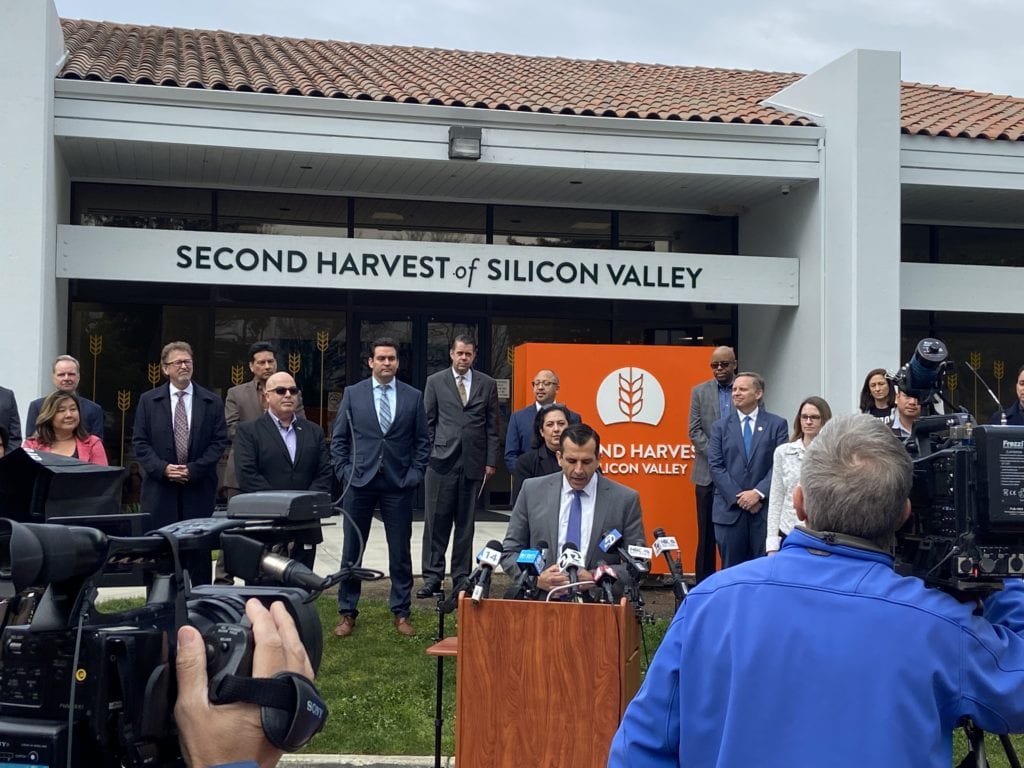Over the past week and a half, Leslie Bacho has watched as the number of volunteers showing up to stock and pack food at Second Harvest Food Bank has halved, just as the need for that food peaks.
The San Jose-based food bank is boxing up food in its warehouse for pickup, rather than have residents come inside, to help reduce potential exposure to the fast-spreading coronavirus, which has infected nearly 200 and killed eight in Santa Clara County alone. But those precautions are putting even more strain on the nonprofit food pantry, said Bacho, the organization’s chief operating officer.
“We need even more volunteer support than ever,” she said. “If we can’t get that support, it will mean we’ll have to hire temporary labor. We’re talking to the National Guard, we’re just trying to figure out whatever resources we can bring in to get the job done because we don’t feel like cutting our services is an option.”
That is a familiar sentiment among nonprofits in Silicon Valley where the highly-contagious virus led to a “shelter in place” order Monday. But as the order sinks in, nonprofits are feeling the effect two-fold: Key fundraisers they rely on have been canceled and volunteers are hesitant to go out, while demand for their critical services is at a fever pitch.
Santa Clara County Supervisor Cindy Chavez said Wednesday the local Meals on Wheels program was short on volunteers to do deliveries.
“We got 10 new sheriffs cadets who are going to be delivering those meals today, but I need those cadets doing other things,” she said.
One in every 14 jobs in California are in the nonprofit sector, but a majority of nonprofits rely heavily on volunteers. At Second Harvest, volunteers do work that would take 100 full-time staff members to accomplish, Bacho said.
And much of the work that paid nonprofit employees do is funded by grants for specific projects, or through events and major fundraisers that often happen in the spring and summer. Many of the largest fundraisers of the year have been canceled or postponed.
Housing Trust Silicon Valley canceled its Investor Briefing, an annual fundraiser that brings in between $320,000 and $350,0000 annually to help the nonprofit fund affordable housing projects and offer other programs.
The chocolates wrapped in white bows and the pens meant to adorn dozens of tables at the March 13 event still showed up, a somber reminder of the unexpected turn only a week before the big day. Staff members packed up the sweets to mail to would-be attendees, hoping requests for refunds wouldn’t leave too big a hole in the budget.
“We were grateful that many sponsors came through with their sponsorship, but we do miss out on ticket sales and day-of donations,” said Kevin Zwick, CEO of the Housing Trust. “The Investor Briefing helps plug the hole in our budget, so any hit to that means that we have to try to make it up somewhere else, and I think we are going into pretty uncertain times for several weeks, if not several months.”


But it’s not just the cancellation of major fundraisers that’s hurting nonprofits.
Housing advocacy nonprofit Silicon Valley at Home, known as SV@Home, hosts many small events to expand affordable housing and information in the region. The group’s website shows a slew of cancellations.
“We do a lot of events and need money and we are having to cancel things that create revenue,” Executive Director Leslye Corsiglia acknowledged. “I think a lot of nonprofits are seeing that right now, regardless of whether they are an essential service or not — their budget includes funding from events.”
SV@Home isn’t an “essential” service, as defined by the county’s shelter in place order, but Corsiglia’s staff is trying to keep work in motion remotely because they partner with many that are considered essential, like city officials and certain developers.
But no one can predict how soon things will return to normal, and Corsiglia is encouraging her employees to put some of their energy toward volunteering while they wait to see how things will proceed.
The ripple effects
In the end, the pressures nonprofits feel will undoubtedly have larger ripple effects throughout the community and the state.
Nonprofits working on thin margins make up a critical cross section of California’s economy and core services, helping to generate about 15 percent of the gross state product and providing services that state, county and city governments rely on heavily to keep communities healthy and happy, according to recent data by the California Association of Nonprofits.
“The nonprofits are pivoting and responding to this new challenge and they’re thinking about how to keep paying their people, about how to keep delivering the critical human services to the community and also other opportunities for enlightenment, like art and culture,” said Kyra Kazantzis, chief executive officer for the Silicon Valley Council of Nonprofits. “One thing that we’re maybe not looking at is that macro effect of suddenly a nonprofit can’t make payroll or it has folks that are out and can’t deliver critical services.”
This month, the School of Arts and Culture at the Mexican Heritage Plaza suspended its after-school arts education programming to protect the community in the wake of the COVID-19 outbreak. The decision will cost the organization $100,000 in revenue this month alone, Jessica Paz-Cedillos and Vanessa Shieh, who lead the school, wrote in an editorial published by San José Spotlight this month.
“These funds support scholarships for students, access to venue spaces for community groups, mentorship for emerging leaders of color and access to a safe cultural hub for families in East San Jose,” the pair wrote.
But while the concerns around funding arts and culture are real and important, Kazantzis said there’s little bandwidth to tackle that issue right now.
“What’s top of mind is getting food to people, getting critical services to people, continuing to somehow deliver mental health services and community health services to people who have the same challenges they had before COVID-19, but now there’s barriers to delivering those critical services,” she said.
Helping the helpers
One bright spot is that many are getting creative to break down some of those barriers.
On Wednesday, city and nonprofit leaders from across the Bay Area announced a new initiative to drum up resources, including volunteers and money to help vulnerable residents, small businesses and community organizations, including nonprofits on the brink of displacement or shuttering for good.
The initiative, called Silicon Valley Strong, includes a website that will become a “one stop shop” for all of the coronavirus resources and information residents need. The site was unveiled alongside the new San Jose Strong fund, launched by the city and Silicon Valley Community Foundation, to benefit people and organizations throughout the valley.
“It is in times of fear like this that history teaches us that there are generations that find uncommon valor,” San Jose Mayor Sam Liccardo said Wednesday at a news conference. “This is our moment to find how we can come together to help one another at a time when so many of our residents are fearful and struggling.”


Meanwhile, foundations that provide funding to nonprofits, like SVCF, are rethinking the rules for funds already doled out to allow more time for project reporting requirements or shifting money to the COVID-19 response, said Avo Makdessian, vice president of strategic initiatives and partnerships at SVCF.
The foundation is also considering offering its own staff to nonprofits that need an extra hand.
“The money, gifts and grants are always great, but at the same time what can we do in kind that practices flexibility?” Makdessian said.
And there’s another bright spot: Even as overall volunteer numbers drop, some Silicon Valley residents seem more determined than ever to keep showing up.
“Last night, even though it was pouring down rain, 20-plus people showed up to help get boxes (of food) out to people in their cars,” Bacho said Wednesday. “That is Silicon Valley strong.”
Contact Janice Bitters at [email protected] or follow @JaniceBitters on Twitter.



Leave a Reply
You must be logged in to post a comment.